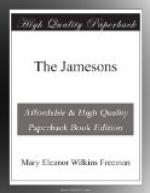Mrs. Jameson not only strove to establish improvements in our midst, but she attacked some of our time-honored institutions, one against which she directed all the force of her benevolent will being our front doors. Louisa and I had always made free with our front door, as had some others; but, generally speaking, people in our village used their front doors only for weddings, funerals, and parties. The side doors were thought to be good enough for ordinary occasions, and we never dreamed, when dropping in for a neighborly call, of approaching any other. Mrs. H. Boardman Jameson resolved to do away with this state of things, and also with our sacred estimate of the best parlors, which were scarcely opened from one year’s end to the other, and seemed redolent of past grief and joy, with no dilution by the every-day occurrences of life. Mrs. Jameson completely ignored the side door, marched boldly upon the front one, and compelled the mistress to open it to her resolute knocks. Once inside, she advanced straight upon the sacred precincts of the best parlor, and seated herself in the chilly, best rocking-chair with the air of one who usurps a throne, asking with her manner of sweet authority if the blinds could not be opened and the sun let in, as it felt damp to her, and she was very susceptible to dampness. It was told, on good authority, that in some cases she even threw open the blinds and windows herself while the person who admitted her was calling other members of the family.
It was also reported that she had on several occasions marched straight up to a house which she had no design of entering, thrown open the parlor blinds, and admitted the sunlight, with its fading influence, on the best carpet, and then proceeded down the street with the bearing of triumphant virtue. It was related that in a number of instances the indignant housewife, on entering her best parlor, found that the sun had been streaming in there all day, right on the carpet.
Mrs. Jameson also waged fierce war on another custom dear to the average village heart, and held sacred, as everything should be which is innocently dear to one’s kind, by all who did not exactly approve of it.
In many of our village parlors, sometimes in the guest-chambers, when there had been many deaths in the family, hung the framed coffin-plates and faded funeral wreaths of departed dear ones. Now and then there was a wreath of wool flowers, a triumph of domestic art, which encircled the coffin-plate instead of the original funeral garland. Mrs. Jameson set herself to work to abolish this grimly pathetic New England custom with all her might. She did everything but actually tear them from our walls. That, even in her fiery zeal of improvement, she did not quite dare attempt. She made them a constant theme of conversation at sewing circle and during her neighborly calls. She spoke of the custom quite openly as grewsome and barbarous, but I must say without much effect. Mrs. Jameson found certain strongholds of long-established customs among us which were impregnable to open rancor or ridicule—and that was one of them. The coffin-plates and the funeral wreaths continued to hang in the parlors and chambers.




